Fractions and Words Representing Quantity... "The Part" Versus "The Whole"!!!
2 Key Tools In Breaking The Fanatic Need For Complete Order In The Autistic Child And Allowing Him To Better Cope With Everyday Situations!!!
Although I knew Zachary has made great strides, I also knew he still struggled with the need for "all or nothing" in almost everything! I had thought long and hard about the best way to "break" this need of his... and I finally came up with the BEST way to approach it... the PERFECT way to teach the "in between"... by teaching FRACTIONS and Words of Quantity, as I call them... words that help illustrate the "partial" or "in between" situation. I tried this and it worked exactly as I had expected. This was sssssssooooo exciting!!!
The idea here was to teach the CONCEPT of "parts" versus the "whole". This was key to teaching the "in between"...what lies between the "nothing" and the "all". Once Zachary saw how "parts" made up the whole, then I could apply that to many, many things in life. He would now have that critical "label" (the fraction) he needed to make sense of his world when it came to the "in between" situation and to figuring out how "parts" can come together to form a whole. I expect this will greatly increase his flexibility in how he looks at things and his ability to cope with the real world. For example, when he wants to open the door completely, I can say: "let's open it halfway"... when he wants me to roll down the car window all the way, I can say: "no, let's leave it up 3/5th of the way" and so on. I can show him how trucks or trains are only partially filled... I can show him that his sandbox buckets can only be filled 1/3 or the way, or 9/10th of the way - instead of him always filling them up completely all the time and not being able to allow for the "in between" situation. I could take a measuring cup and show him the various levels by filling it up 1/4 of the way and showing him "1/4" on the cup, etc. So, the key was just to teach the CONCEPT of "parts" verses the "whole".
Note that the tools I use (below) were for grades 2-6... but, that did not matter. Zachary did not need to learn how to add or subtract or multiply or divide fractions... he just had to learn the concept behind them - that parts make up a whole - and then apply that to the "in between" situation so that a task did not have to be done "completely". It could be done "partially"... and that... any child can learn from a very young age.
At first, I just took out the "new tools" I bought and let Zachary play with them. Below are pictures of the "tools" I decided to use: The Fraction Stax (by Ideal School Supply Company) and Fraction Pieces (by Didax Inc.).
I chose these for specific reasons. The Fraction Stax was a 3-D tool... and it had a lot of color to it. I felt "one color" per "fraction concept" or "piece" would help reinforce the lesson. I also felt that in the past, Zachary responded more to 3-D objects than to products that were simply kind of like a puzzle... a flat surface. He found the 3-D products much more interesting. This particular product was made by Ideal School Supply Company (they also make the plastic shapes I used. This company was located in Alsip, IL). The Fraction Stax was product no. 7749. Parents should be able to get this product from pretty well any school supply store in their area. It costs approximately 25.00 US (when you include shipping and handling).
A company that sells this product is Summit Learning at 755 Rockwell Avenue, P.O. Box 755, Fort Atkinson, WI 53538-0755, Phone: 800-777-8817, Fax: 800-317-2194, E-mail: info@summitlearning.com, website:http://www.summitlearning.com/ent/search_results.cfm.
The Fraction Pieces by Didax cost me 15.00 US. They provide more of a 2-dimensional exercise but, you can use them to create your own 3-D masterpieces! The item no. for the Didax product is 2-497. Didax was located in Rowley, MA. Again, I obtained these at my local school supply store. Note: Both products say they are for children over 3 yrs of age (chocking hazard), therefore, parents should always be there monitoring young children while they work with these!
Tool 1 - The Fraction Stax - by Ideal School Supply Company
What I believe could be the best tool yet for the autistic child!!!
First, I took the fraction stacks and put one of each "fraction" on a stack in descending order and/or ascending order - good to try both. This way, I was showing Zachary, 1) the whole and then 2) the parts from "bigger" to "smaller" parts. This tool was nice because the fractions were marked on the pieces... 1, 1/2, 1/3, 1/4, 1/5, 1/6, 1/8, 1/10 and 1/12. I called off the "fraction" with each piece I placed... each and every time I put a piece on the stacks... that was key in getting across the concept of "parts" versus the "whole". When I did the "calling out" for exercises shown further below... where an "entire stack" was made, I called out the pieces one at a time in addition to showing the "relation" to the whole. For example, when making the stack of "quarters" (the pink blocks), I would say, as I picked up the first 1/4 piece: 1/4 (and put the first block on), then, I'd say: 1/4 + 1/4 as I put the second block on and I would provide the answer... "equals 2/4".
Note: I did NOT say "=1/2"... we were working with "quarters" and so I had to stay with the "quarters" in order not to confuse Zachary (you do not want to "simplify the fraction" by calling it 1/2...that would ruin the "concept" of the "part" of a "whole").
I then took the third piece and said: 2/4 + 1/4 = 3/4 and then I took the final piece and said: 3/4 + 1/4 = 4/4 and I ended with 4/4 = 1. I did this for every "stack" of fractions - taking each piece or part and working up to the whole for each stack. I did this "calling out" for the entire 2 hours we worked on this.
Note: Zachary was so fascinated by this concept, that he had absolutely no problem working with this tool for several hours nonstop!
In no time, Zachary was calling out "the additions" himself. :o)
Note: The first arrangement of the stacks provided a somewhat "ordered" visual for Zachary... the tool was still fairly new... so, he was still "enjoying" just watching for now. I then took some of the pieces and started to mix them up... putting them "out of proper descending or ascending order"... as shown in the second picture below.
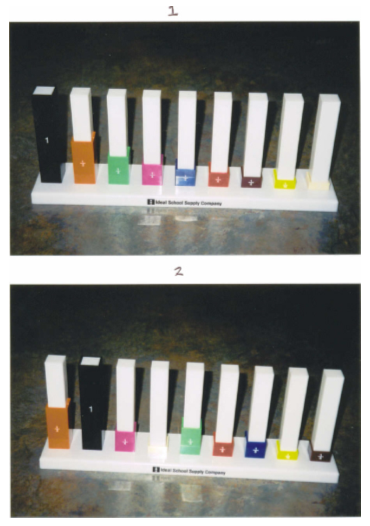
Now, it was Zachary's turn to play with this item. He immediately sensed anxiety and/or frustration from seeing things "not complete"... so, he turned the stacks around to make all the fractions fall off. He then "started over" on his own... doing things the way he wanted them... in an ordered, "all or nothing" manner as shown in the first picture below. By this, I mean that ALL the pieces had to be on the stacks and in the right place. For Zachary, at first, there could be no pieces left on the floor and no mixing of colors... his "all or none" world mandated that! I worked with him a long time, calling out the "parts" and adding them to make the whole for each stack (as described in the example above the first picture in this section of my website).
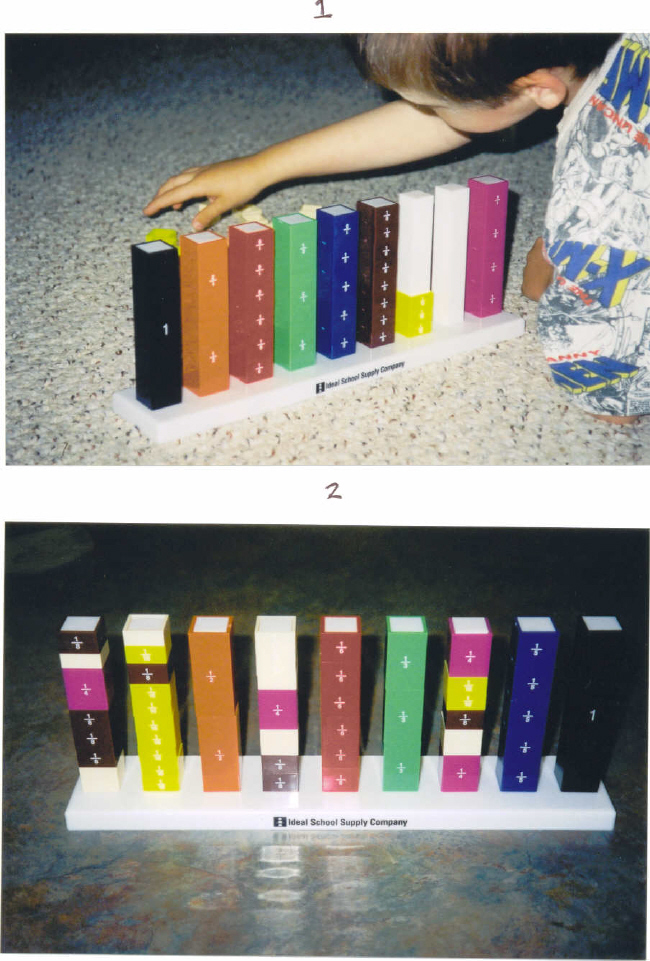
I then took the stacks and started to "mix them up", calling them "mixed up stacks" as I did this (to provide that all too necessary "label"... labeling everything, I found, was key to helping Zachary cope with the "unusual", the "unknown", and/or "the new"). Notice I still used ALL the pieces. I then waited to see what Zachary would do with the mixed up stacks...
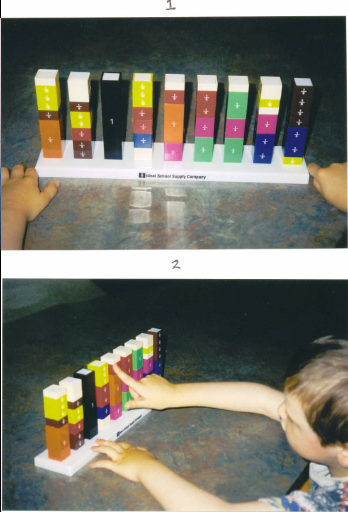
To my surprise... Zachary did not flip over the stacks to "undo" the mixing and matching of sizes and colors. Instead, he ran his fingers "up and down" each "mixed up stack"... he was "taking in" the variation. After doing this a little, he then flipped over the stacks to "undo" them. So, mixing of colors and sizes was no longer "as big an issue" as it had been slightly earlier. Zachary adapted rather well to that.
The variation that absolutely drove him crazy - as I knew it would - was the "incomplete" or "partial" stack! I stacked the pieces as shown below. I did not "complete" the task and put the missing pieces aside where he could not get to them. Right away, Zachary went ballistic, screaming and then taking the stacks and flipping them over and scattering the pieces everywhere so that they were no longer seen as part of a "whole" (exactly the same behavior I had seen in the past with the Easter Egg exercises - See Plastic Eggs section)! I had fully expected this to happen... and sure enough, it did!

Zachary played with the Fraction Stax for over 4 hours that day... at times with me there, and at times, on his own... just to "experiment" by himself.
When "partiality" became too much of an issue, the result was always the same (see Exercises for more on this) - Zachary either looked for that all important "order fix" and if one could not be found, then the "partial" had to be completely, and again, as in this case, actually physically separated from the whole... so that the pieces were no longer perceived as something associated with the "whole". Those pieces he has so much difficulty making sense of were forced into randomness... an unexpected coping mechanism for the autistic child... yet, when looked at in terms of inability to deal with the partial in "anything", even this coping mechanism now made perfect sense!
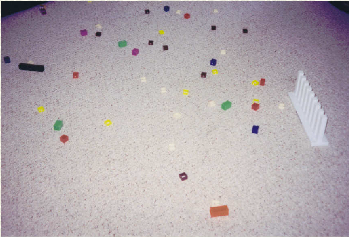
There was, however, one very interesting thing Zachary did start to do... he started stacking the pieces so that they went "beyond" the stack... something totally new! These were "labeled" as "smokestacks". For example, he would take the 1/2 piece, top it with a 1/3 or 1/4 piece and then top that with another 1/2 piece so that the stack now went "higher" than the normal level... beyond the others... and he was totally fine with that.
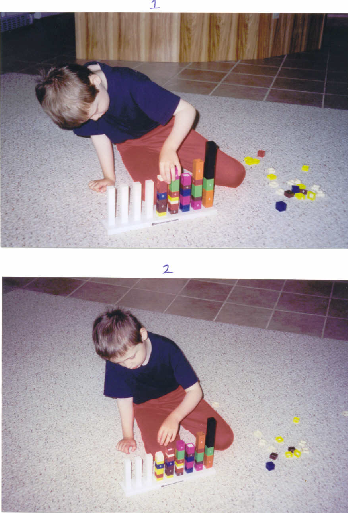
So, this was very interesting... the "beyond the whole" was ok... it was really just the "partial", the "less than whole" that seemed to be an issue and still is... and that was why understanding fractions, in my opinion, was so key to children like Zachary. To recognize that parts made up the whole would be critical... and would be applicable to everyday life to help autistic children cope with the "partial" or "in between" situation. For example, opening the door 1/2 way... the fraction provided the "label" that was so critical to Zachary for him to accept this as "normal"... to be able to say: "Oh, this is 1/2 way"... to understand that concept! And actually, when I used the 1/2 open door example with Zachary, I could see him "clicking"... understanding what I was saying and "thinking this was cool"... providing that label... I am convinced was KEY!
The importance of labels in the life of the autistic child simply can not be overestimated. It is the use of labels that allows the child to perceive the "part of the whole". For example, in the pictures below, Zachary decided to make a "FractionStax Truck". He decided to create "a whole" with the "parts" before him... yet, another coping mechanism... only this one has a double-edged sword!

The creation of the "FractionStax Truck" allowed Zachary to cope with "the in between", the "partial", because, now the object before him was no longer a "FractionStax" with missing pieces that caused so much frustration, the object BECAME a FractionStax TRUCK! It was no longer its previous "self" and had been replaced by a "NEW ENTITY". This object was now labeled by Zachary as his FractionStax Truck and Trailer.
Since trucks and trailers vary in real life, he seemed perfectly fine with having "partial" pieces on the truck... it did not have to be perfect... just to look like a truck was sufficient. A trailer could have "pieces" on it, because trailers hauled stuff... and so, even fraction pieces were ok. Zachary now saw the "FractionStax" not as the tool it was intended to be but as a whole new entity... a truck. He was happy and content with that new entity. Frustration had left him since he was even able to "walk away" and "leave his truck" all by itself. Gone was the need to scatter all pieces - my valuable tool, once viewed as too frustrating, had been replaced by something Zachary could better cope with... a new entity... in this case, a truck and trailer... and this now became his focus.

The point here was that this coping mechanism allowed Zachary to see this FractionStax as a NEW ENTITY... a TRUCK and TRAILER... and with that came the problem. Zachary no longer wanted to use the object as a learning tool to teach fractions. He simply wanted to "make his truck" - no matter how hard I tried to simply use the tool to teach fractions again. So, the "creation of a whole and new entity from partial entities" became a coping mechanism with a double-edged sword. The trick, perhaps was to make absolutely sure Zachary had learned the concept of fractions before allowing him to use the tool as "something else". As a person "blazing the trail", however, for me, this had been a HUGE problem!
Over and over again, I had seen Zachary "take" to a specific task and then not want to do it any longer -ever! He "just did seem interested in learning the concept any more" (although I think he did have a very good understanding of it simply because I worked with him for just over 2 hours to start with and I knew he understood what I was doing). He had turned my tool into something with which he could better cope and so, it became very difficult to teach using any repetition - something believed to be so necessary in many learning situations. Yet, his coping mechanisms prevented that repetition from occurring. This had been a very difficult issue to overcome with Zachary - and I suspect it would be, similarly, with all autistic children. This would certainly explain why behavior therapy can be so difficult with these children. The creation, or simple "perceiving" of a "new entity" made it very difficult to go back to the original task/lesson at hand.
Interestingly, the "FractionStax truck" then completely took over and it too became a source of frustration. Now, this new entity, if not perfectly aligned or "just right", resulted in the eruption of tremendous frustration once again. Now, there could be no truck without a trailer... the wheels had be able to sustain the whole, with no pieces falling off as that would send Zachary screaming.
I had spent $25.00 on a tool that had been turned into something I now had to find new ways of using. This demanded a great deal of creativity. I suppose I could call the stacks "brick stacks" to create yet another entity in Zachary's mind. To be unable to "constantly create new entities" would mean that my so precious tool would become completely useless!
Of course, there were ways of getting around this. A simple option of "putting it away for a while" and then, later, taking it out again to try once more to use the tool for its intended purpose was something I had done with many other tools and that often seemed to work. In spite of these difficulties in overcoming Zachary's coping mechanism tactics, however, I had accomplished what I wanted. Zachary did after all understand the concept of fractions... and to me, that was key. I could then apply that concept to so much more in his life... to help him cope with his world and issue with partiality!
The need to constantly be looking for "something new" in teaching these children - to keep one step ahead of them - I had found to be true in so many things I did with Zachary. I wondered how I would teach concepts like math, language and so much more that seemed to necessitate repetition. Often, working with Zachary felt like an overwhelmingly difficult and exhausting task - in spite of the progress we were making. Patience, understanding and creativity - if you did not possess these qualities, working with an autistic child was certainly a way of working on that! :o)
Tool 2 - Fraction Pieces - by Didax
Another great tool for the autistic child...
Parents can buy a lot of different fraction products. I also liked this one in particular. I would have preferred having the pieces labeled as were the Fraction Stax, however, there was also something to be said for having the child learn to count the pieces for each "whole"... thereby helping him learn the fractions even more... so, I went with this particular product... and found it worked well too!
Pieces that "snap together" and "stack on top of each other" would have been great... but I found none like that! Anyway, the idea here was pretty much like that described above in Fraction Stax... start with the ordered and move to the mixed up... then take pieces, count up to the whole ... each time. Having various fraction tools on hand, in my view, was also a good idea. When one tool assumed another identity, you could pull out another! When that one too took on a new identity, you could pull something else out (i.e., a pair of scissors and paper and make your own fraction pieces and put them together).
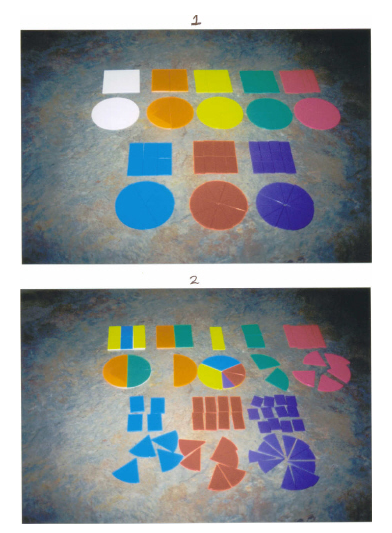
The first picture below was the one that turned Zachary "ballistic"- obviously - when my circles looked like "pacmans"... with a piece or two missing from the whole. I also "stacked" these circles on top of one another as I did them, adding the parts to make the whole each time...calling them out each time... same thing for the squares... then, I removed pieces and worked backwards to give Zachary enough exposure to the task at hand... this provided "some stress" when you remove some... but, if I called out "how many were left" (i.e., 12/12th minus 1/12th = 11/12th as I removed the first piece from the completed stack, I found it provided a coping mechanism in that there was the "anticipation" of the next "complete circle" followed by the stress of the "partial" as the "next" circle or square was "slowly pulled apart" while calling out the "subtraction" of fractions. For example, 12 twelfths minus 1 twelfth = 11 twelfths and all the way down.
Note: It was important to do "proper labeling" to "maintain" the concept of "part versus whole". For example, I would NOT simply say 12-1 = 11... that would be wrong... these were FRACTIONS and they needed to REMAIN as FRACTIONS... that meant TWELFTHS (in this example) and so on. The ONLY whole number that should EVER be used in this entire exercise was the number ONE...when you reach "the whole"... pronunciation was also KEY... I was not working with "twelve" but rather "twelfths"!!! Since Zachary could read, I could show him the actual spelling of words dealing with fractions and that was helpful too (i.e., half, third, quarter, fifth, sixth, eighth, tenth, twelfth)!

WORDS OF QUANTITY!!!
There were several words that, if used in conjunction with the above "fraction" exercises, really helped Zachary gain a greater understanding of the entire concept of the "part" verses the "whole". Click here for this list of words. There are certainly many more, but these words were a good start to help teach the concept of "quantity". I used these words in asking Zachary to give me a certain amount of the fraction pieces I had for the exercises above. When Zachary was able to give me the "correct amount", I knew the lesson of "fractions" had been learned and I could apply the concept of parts to the whole and generalize to the "real world". I could now say: "Give me "some sand in the bucket".... or "fill the bucket 2/3 of the way up", etc., etc., etc.
In no time at all, I was already seeing this work in some aspects of life for Zachary and I was confident teaching the concepts of "fractions and words of quantity" would work for many, many other autistic children as well! The only thing was to work at avoiding those "coping mechanisms", like the creation of randomness and the creation of a whole new entity. Perhaps the trick to that was simply to do much shorter "sessions" in teaching these concepts. Enthusiasm can sometimes have a way of working against you. :o)
The key, in my opinion, was to constantly come up with "new labels" for the task... to show the child that you were using the same tools to do "something different". This was a very difficult task... but, in my opinion, this was the key to having "continued use" of these excellent tools that can so help the autistic child deal with his world and his issues with partiality!